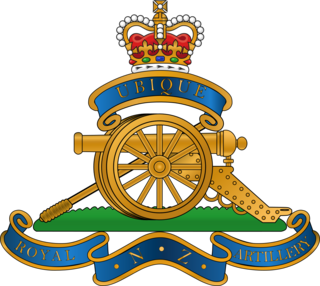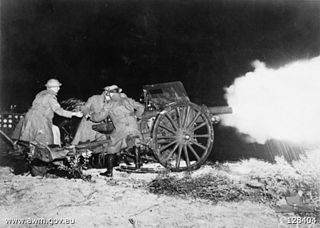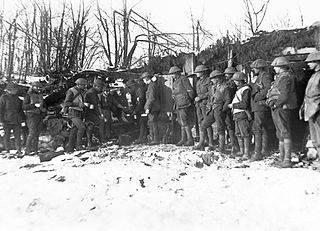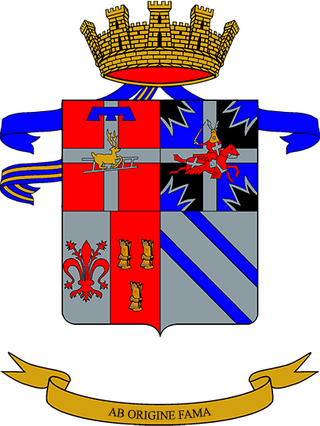Related Research Articles

The Royal Regiment of New Zealand Artillery is the artillery regiment of the New Zealand Army. It is effectively a military administrative corps, and can comprise multiple component regiments. This nomenclature stems from its heritage as an offshoot of the British Army's Royal Artillery. In its current form it was founded in 1947 with the amalgamation of the regular and volunteer corps of artillery in New Zealand. In 1958 in recognition of services rendered it was given the title the Royal Regiment of New Zealand Artillery.
The 48th Field Battery, Royal Australian Artillery was an artillery battery of the Australian Army. The battery traced its lineage back to a unit that was formed for service during the First World War. Assigned to the 9th Brigade, it was located at Keswick Barracks in South Australia until mid-2013 when it was amalgamated with the Launceston-based 16th Field Battery, to form the 6th/13th Light Battery.

The 1st Regiment, Royal Australian Artillery is a close support regiment attached to the 7th Brigade at Enoggera Barracks in Queensland. The unit was formed in 1914 under the name 1st Australian Field Artillery Brigade, part of 1st Division Artillery during World War I and later served in World War II and the Vietnam War. It is currently re-equipping with M777A2 lightweight towed howitzers.
41 Field Battery, Royal Australian Artillery was formally raised in Egypt during March 1916 for service with the 11th Field Artillery Brigade, part of 4th Division Artillery. Today 41st Field Battery is one of 4 batteries that make up the 1st Field Regiment, part of 7 Brigade.

The 104 Field Battery, Royal Australian Artillery was formed in the town of Moascar in Egypt during March 1916 during the First World War, as the 104th Field Artillery (Howitzer) Battery, part of 4th Field Artillery Brigade. The battery was disbanded in 1919, but the name was used for a new battery raised in 1965, which later formed part of the Australian military involvement in the Vietnam War. It is now one of three gun batteries in 1 Regt RAA.
The 4th Regiment, Royal Australian Artillery is an artillery unit of the Australian Army. Currently it provides close artillery support to the 3rd Brigade and is based at Chau Pha Lines, Lavarack Barracks in Townsville, Queensland. The regiment was raised in its current form in 1960 and is currently re-equipping with M777A2 lightweight towed howitzers. The regiment deployed during Australia's commitment to the Vietnam War and has subsequently deployed to Singapore and East Timor.

The 105th Medium Battery is a unit of the Royal Regiment of Australian Artillery that can trace its history back to March 1916, when it was raised as 105th Howitzer Battery in Egypt. The battery is based at Gallipoli Barracks, Enoggera, Queensland, as a full-time regular army unit and is one of three batteries that make up the 1st Regiment, in the 7th Brigade.
3rd Regiment Royal Horse Artillery is a regiment of the Royal Horse Artillery in the British Army. They are currently based at Albemarle Barracks, Northumberland, England.

The Sri Lanka Artillery (SLA) is the artillery arm of the Sri Lanka Army. It is made up of ten regular regiments and two volunteer regiments. The SLA is headquartered at Panagoda Cantonment, Panagoda.

The 1st Field Artillery Regiment (Mountain) (Italian: 1° Reggimento Artiglieria Terrestre (montagna)) is a field artillery regiment of the Italian Army, specializing in mountain warfare. The regiment is based in Fossano in Piedmont and assigned to the Alpine Brigade "Taurinense". The regiment is the Italian Army's senior mountain artillery regiment as it was formed in 1887 by the Royal Italian Army. In World War I the regiment's groups and batteries served on the Italian front.

The 5th Mountain Artillery Regiment is an inactive mountain artillery regiment of the Italian Army, which was based in Meran in South Tyrol. The regiment was formed in 1935 by the Royal Italian Army with batteries that had served in World War I. The regiment was assigned to the 5th Alpine Division "Pusteria", with which it served in the Second Italo-Ethiopian War and during World War II in the invasion of France and the Greco-Italian War. After the invasion of Yugoslavia the regiment served as occupation force in Montenegro. In 1943 the regiment was transferred to the South of occupied France. After the announcement of the Armistice of Cassibile on 8 September 1943 the regiment was disbanded by invading German forces.
The 8th/12th Regiment, Royal Australian Artillery, was formed at the Holsworthy Barracks on 16 November 1973 through the amalgamation of the 8th Medium Regiment (RAA) and the 12th Field Regiment (RAA). The Regiment provides field artillery support to the 1st Brigade based in Darwin. It is currently equipped with 155mm M777 Howitzers.
The 7th Field Regiment, Royal Australian Artillery was an Australian Army Reserve artillery unit with its headquarters at Pymble, New South Wales, and was part of 8th Brigade until it was disbanded in early 2013.
The 102nd Medium Battery was an artillery battery unit of the Royal Australian Artillery. The battery was formed in 1957, known as the 102nd Field Battery and served in the Indonesia–Malaysia confrontation and the Vietnam War before being disbanded in 1987.
The 103rd Medium Battery is an artillery battery unit of the Royal Australian Artillery. The battery was formed in 1916, known as the 103rd Field (Howitzer) Battery and served during World War I. Its successors have fought in the Indonesia–Malaysia confrontation and the Vietnam War and the battery is currently part of the 8th/12th Regiment, Royal Australian Artillery, based in Darwin, Northern Territory, as part of the 1st Brigade.
The Order of battle, Keren 1941 shows Italian army forces that participated in the Battle of Keren from February to March 1941 and British troops in Sudan on 20 January 1941, which participated in military operations against Eritrea during the East African Campaign 1940–1941.
In 1989, the United States Army Pacific had its headquarters at Fort Shafter in Hawaii, and its units were stationed within the United States. Overseas forces included the US Army Japan, and the Eighth US Army in South Korea.
The 9th Regiment, Royal Australian Artillery is an artillery regiment of the Australian Army. It draws lineage from an artillery unit raised in 1903, which provided personnel to artillery units raised for service during World War I seeing action on the Western Front. It was mobilised for service during World War II and undertook defensive duties in Australia before being disbanded in 1944. The regiment was re-raised as part of the Australian Army Reserve in 2018, and currently provides artillery support to the 2nd Division. It consists of six light batteries, which are based at numerous depots around the country. The regiment's headquarters is based in Sydney, New South Wales.
The 23rd Regiment, Royal Australian Artillery was an Australian Army artillery regiment of the Australian Army. Raised in 1948 as a Citizen Military Forces anti-tank unit designated the 3rd Anti-Tank Regiment, it was converted to a field artillery regiment in the 1950s. It supported the 5th Brigade until being reduced to a battery-sized sub unit, and assigned to the 9th Regiment, Royal Australian Artillery in 2018.

The 5th Field Artillery Regiment "Superga" is a field artillery regiment of the Italian Army. The regiment is the army's only multiple rocket launcher unit and equipped with M270A1 MLRS-I launchers. The regiment is based in Portogruaro in Veneto and assigned to the Artillery Command. The regiment is the Italian Army's senior artillery regiment and was formed in 1850 by the Royal Sardinian Army. In 1855-56 the regiment deployed six batteries to Crimea for the Crimean War and in 1859 it fought in the Second Italian War of Independence. In the 1860 it participated in the Piedmontese invasion of Central and Southern Italy. In 1861 the regiment joined the Royal Italian Army and in 1866 it fought in the Third Italian War of Independence. During World War I the regiment served on the Italian front. In 1935 the regiment was assigned to the 1st Infantry Division "Superga", which in 1940 participated in the invasion of France. In fall 1942 the division was transferred to Tunisia for the Tunisian campaign. The division and its regiments surrendered there to the British forces on 12 May 1943.